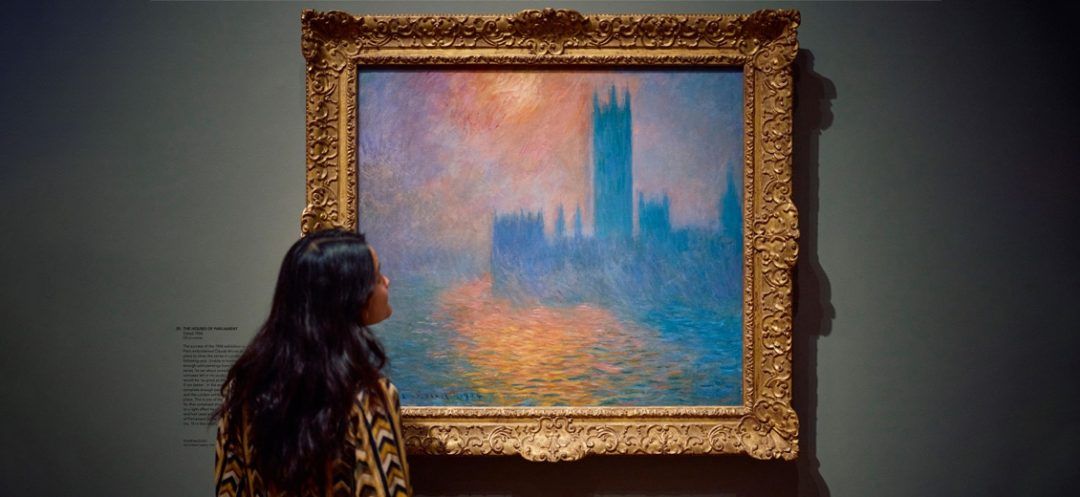
Monet's love for London's enchanting smog takes center stage in a new Courtauld Gallery exhibition, Monet and London: Views from the Thames. The display features 21 paintings sourced from private collections and museums in France, the United States, Ireland, and beyond.
In London, Claude Monet found a peculiar allure in the famed "smog," a haze born from industrial pollution that bathed the city in a mystical light. For the first time, his paintings of the Parliament and the Thames are displayed in the British capital, fulfilling a wish he harbored 120 years ago.
The impressionist painter visited London multiple times between 1899 and 1901, then the world's most populated city and a significant industrial hub. He aimed to capture the "effects of the fog on the Thames" and created an entire series of works centered around the river.
Monet stayed at the Savoy Hotel, where he enjoyed a sweeping view of the Waterloo and Charing Cross bridges. To paint the Palace of Westminster, the British Parliament, he crossed the river and set up his easel on a terrace at the still-active Saint Thomas Hospital.
"Each day, I find London more beautiful to paint," Monet wrote to his stepdaughter in 1900. In a letter to his wife, he spoke of the ever-changing weather and his fascination with the effects on the Thames.
In 1901, he described to an American journalist how the fog "dressed in all sorts of colors"; black, brown, yellow, green, violet, and how the sun barely pierced through the dense smoke. In one painting, the outlines of Charing Cross Bridge are barely visible against a yellow backdrop, likely tinted by sulfur emissions. This particular work was gifted to Winston Churchill in 1949 by his literary agent, who urged him to "dispel the fog shrouding Westminster."
Karen Serres, the curator of the exhibition at the Courtauld Gallery, explains that Monet's favorite season in London was winter, when "the fog mixed with pollution, factory smoke, and all the particles in the air." She adds, "Monet also loved the moments when the clouds would briefly part and a ray of sunshine lit up the Thames."
After his stays in London, Monet would return to Giverny, north of Paris, with dozens of canvases to complete in his studio. In 1904, about forty London paintings were exhibited in Paris. Monet had intended to organize this exhibition in London, but the paintings sold too quickly, thwarting his plans.
A Charing Cross Bridge painting owner wrote to Monet upon his return to England after seeing the Paris exhibition: "You have enabled us to better understand this magnificent landscape," he praised.
While Monet's pollution-covered London might appear "an enchanted place," Serres notes, "I'm sure it was not the case at all for its residents." Nonetheless, the critic from The Times, who evidently enjoyed the exhibition, whimsically suggested bringing back the fog, provided it could assume the "enchanting and strange hues" of Monet.
The exhibition Monet and London: Views from the Thames, runs until January 19.
In London, Claude Monet found a peculiar allure in the famed "smog," a haze born from industrial pollution that bathed the city in a mystical light. For the first time, his paintings of the Parliament and the Thames are displayed in the British capital, fulfilling a wish he harbored 120 years ago.
The impressionist painter visited London multiple times between 1899 and 1901, then the world's most populated city and a significant industrial hub. He aimed to capture the "effects of the fog on the Thames" and created an entire series of works centered around the river.
Monet stayed at the Savoy Hotel, where he enjoyed a sweeping view of the Waterloo and Charing Cross bridges. To paint the Palace of Westminster, the British Parliament, he crossed the river and set up his easel on a terrace at the still-active Saint Thomas Hospital.
"Each day, I find London more beautiful to paint," Monet wrote to his stepdaughter in 1900. In a letter to his wife, he spoke of the ever-changing weather and his fascination with the effects on the Thames.
In 1901, he described to an American journalist how the fog "dressed in all sorts of colors"; black, brown, yellow, green, violet, and how the sun barely pierced through the dense smoke. In one painting, the outlines of Charing Cross Bridge are barely visible against a yellow backdrop, likely tinted by sulfur emissions. This particular work was gifted to Winston Churchill in 1949 by his literary agent, who urged him to "dispel the fog shrouding Westminster."
Karen Serres, the curator of the exhibition at the Courtauld Gallery, explains that Monet's favorite season in London was winter, when "the fog mixed with pollution, factory smoke, and all the particles in the air." She adds, "Monet also loved the moments when the clouds would briefly part and a ray of sunshine lit up the Thames."
After his stays in London, Monet would return to Giverny, north of Paris, with dozens of canvases to complete in his studio. In 1904, about forty London paintings were exhibited in Paris. Monet had intended to organize this exhibition in London, but the paintings sold too quickly, thwarting his plans.
A Charing Cross Bridge painting owner wrote to Monet upon his return to England after seeing the Paris exhibition: "You have enabled us to better understand this magnificent landscape," he praised.
While Monet's pollution-covered London might appear "an enchanted place," Serres notes, "I'm sure it was not the case at all for its residents." Nonetheless, the critic from The Times, who evidently enjoyed the exhibition, whimsically suggested bringing back the fog, provided it could assume the "enchanting and strange hues" of Monet.
The exhibition Monet and London: Views from the Thames, runs until January 19.
Read more



Comments